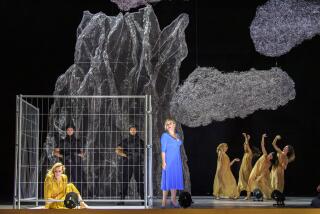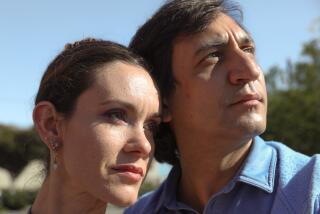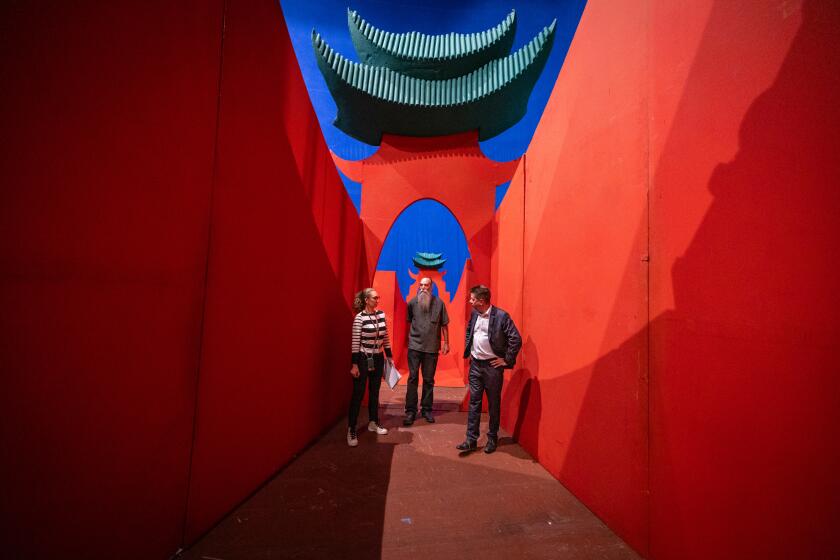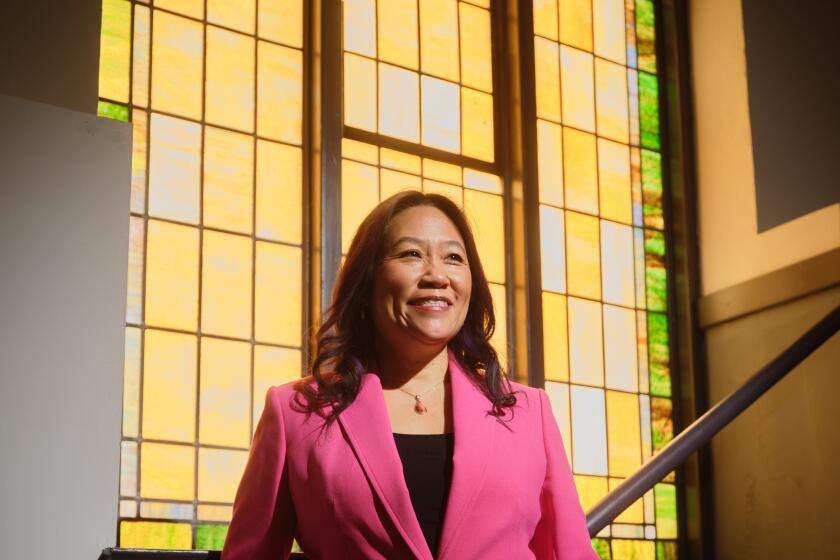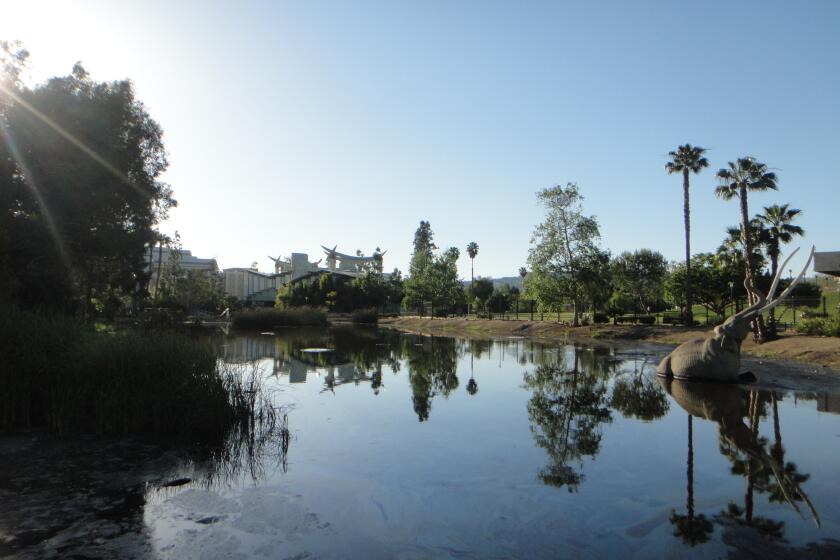‘Cinderella’ Story : Ballet: Lyon Opera Ballet’s avant-garde work garners both bouquets and brickbats. It comes to San Diego this weekend.
Whether they considered it “astonishingly original and magical” or “adolescent scribblings smeared over the surface of a poignant original,” there is one response the critics have not had to the iconoclastic production of “Cinderella” staged by the Lyon Opera Ballet. No one has been lukewarm.
“It is (choreographer) Maguy Marin’s remarkable achievement to have created a vision of lost childhood, of innocence seen from a distance,” raved New York Times critic Anna Kisselgoff in a review of the U.S. premiere of the evening-length ballet. The ballet opens Friday at the San Diego Civic Theatre, a presentation of the San Diego Foundation for Performing Arts.
Among those who objected at that time to the flashy “Cinderella,” Dance Magazine’s Camille Hardy took the Lyon Opera Ballet to task for “the pursuit of novelty for its own sake.”
When the ballet came to Los Angeles in 1989 The Times’ critic Martin Bernheimer admired the brilliant stagecraft, but complained of the production’s “bleak Expressionism” and said that it had “raped and trivialized” the Prokofiev score. Spliced into the original music are taped baby gurgles, the work of composer Jean Schwarz.
And, if that sounds avant-garde, consider that all of the dancers wear somewhat grotesque masks and lumpish padding, turning them into life-size dolls on the three-storied dollhouse set.
“It’s not only the story of Cinderella, it’s a story about childhood,” said Yorgos Loukos, Lyon Opera Ballet’s artistic director, speaking by telephone from Pittsburgh, where the company began a seven-city U.S. tour last weekend. “You see how rude children can be, how charming. . . . It’s a very magic world and also a cruel world.”
Loukos danced with the Theatre du Silence in Paris and Roland Petit’s National Ballet of Marseilles, before joining the Lyon Opera Ballet as assistant director in 1984. That same year, the city of Lyon staged its first Biennale de la Danse. Both the biennial festival and the ballet company have helped each other grow in international importance since then.
Loukos has heard the criticisms of “Cinderella,” but he vigorously defends the practice of radically reinterpreting the classic ballets.
“It’s a pity to have those wonderful stories, those wonderful scores, and be obliged to see them only in a very conventional and sometimes very old-fashioned version,” he said in rapid, barely accented English (Greek-born, he is fluent in half a dozen languages). “When you’re doing Shakespeare or Moliere, you always have new productions. Why shouldn’t one do the same thing with dance? Why shouldn’t we have our Peter Brook and our Robert Wilson and our Peter Sellars?
“If you only watch what people have done yesterday, you will become yesterday yourself.”
Besides “Cinderella,” the company’s repertoire includes a contemporary “Romeo and Juliet,” which French choreographer Angelin Preljocaj set among homeless people. And Maguy Marin is creating a new “Coppelia” scheduled to premiere in 1993.
Marin choreographed her first piece for the Lyon Opera Ballet in 1979. With “Cinderella,” premiered in France in 1985, she gave the company its first major commercial success. Last year, she became the first resident choreographer since the company was founded more than 30 years ago.
According to Loukos, Marin was selected because “she represents very well what we call la jeune danse francaise --young French dance.” Dance, especially modern dance, has boomed in France during the past 15 years, he said, thanks to dramatically increased support from the Ministry of Culture.
One might also surmise that the Lyon Opera Ballet, which has developed a reputation for taking risks, welcomes the controversy that is often aroused by Marin’s work. Cries of “Shame!” as well as cheers greeted the 1989 premiere of her “Hey, What’s All This to Me!?”, a caustic rock musical about the French revolution performed by her own Compagnie Maguy Marin. (Marin herself sang some of the songs.)
Although Marin’s appointment at the Lyon Opera Ballet represents a departure from the company’s longstanding policy of not having a resident choreographer, Loukos emphasized that she will contribute only one work per year. The company will continue its trademark practice of commissioning new dances from a wide variety of choreographers.
Recent additions to the repertoire include works by several Americans, including Bill T. Jones and Ralph Lemon. In addition, Lemon, Karole Armitage and Lucinda Childs each choreographed sections of “Dancing Zappa,” a three-part work to symphonic--yes, symphonic--music by Frank Zappa. It premiered at the 1990 Lyon Biennale, which was dedicated to American dance.
Although most of its latest commissions are from modern dance choreographers, the company continues to use dancers who are classically trained.
“I would say we subvert them,” Loukos said. “(Dancing to extremely varied choreography) is the best way to get richer, both physically and mentally--through confrontations with different styles, with different artists from different places, where they have confrontations with different social situations. It’s a wonderful way of becoming a real artist.”
To stretch their classical training, the dancers have taken technique classes from dancers from the companies of Ralph Lemon and Bill T. Jones. Marin has said that one reason she used masks in “Cinderella” was to force the dancers not to rely on classical conventions, but to express emotion through movement alone.
A truly international company, the Lyon Opera Ballet’s 31 dancers represent 10 nationalities. They maintain a vigorous touring schedule that has taken them to more than 40 countries, including Australia, India, Brazil, China, and African countries, as well as Europe and North America.
The first performance of “Cinderella,” for example, took place in Lyon, the 100th in New York and the 200th in Beijing. Reactions to the ballet have varied according to the audience’s nationality, Loukos said.
“American audiences have a sense of humor that you don’t usually find in Europe,” he remarked. “They tend to laugh throughout the piece. In China, the use of masks reminds the audience very much of Chinese opera. It’s very close to their stylized theater.”
What of young audiences? Although this retelling of Cinderella is supposedly through a child’s eyes, do children find the masks--and the sometimes violent interactions among the characters--too frightening?
Not at all, according to Loukos. “There’s a little girl in Bologna, Margo--a great name for a ballerina (like Margot Fonteyn). Every time we perform in Italy, whether in Bologna or Rome or another city, the mother is bringing her around, because she’s only talking about Cinderella.”
‘ ‘Cinderella” will be performed Friday and Saturday at 8 p.m. and Sunday at 3 p.m. at the Civic Theatre. Half-price tickets are being offered to each child under 14 accompanied by an adult. For more ticket information, call the San Diego Foundation for Performing Arts at 234-5853.
More to Read
The biggest entertainment stories
Get our big stories about Hollywood, film, television, music, arts, culture and more right in your inbox as soon as they publish.
You may occasionally receive promotional content from the Los Angeles Times.

